Abstract
We review the factors influencing children's exposure to environmental contaminants and the data available to characterize and assess that exposure. Children's activity pattern data requirements are demonstrated in the context of the algorithms used to estimate exposure by inhalation, dermal contact, and ingestion. Currently, data on children's exposures and activities are insufficient to adequately assess multimedia exposures to environmental contaminants. As a result, regulators use a series of default assumptions and exposure factors when conducting exposure assessments. Data to reduce uncertainty in the assumptions and exposure estimates are needed to ensure chemicals are regulated appropriately to protect children's health. To improve the database, advancement in the following general areas of research is required: identification of appropriate age/developmental benchmarks for categorizing children in exposure assessment; development and improvement of methods for monitoring children's exposures and activities; collection of activity pattern data for children (especially young children) required to assess exposure by all routes; collection of data on concentrations of environmental contaminants, biomarkers, and transfer coefficients that can be used as inputs to aggregate exposure models.
Full text
PDF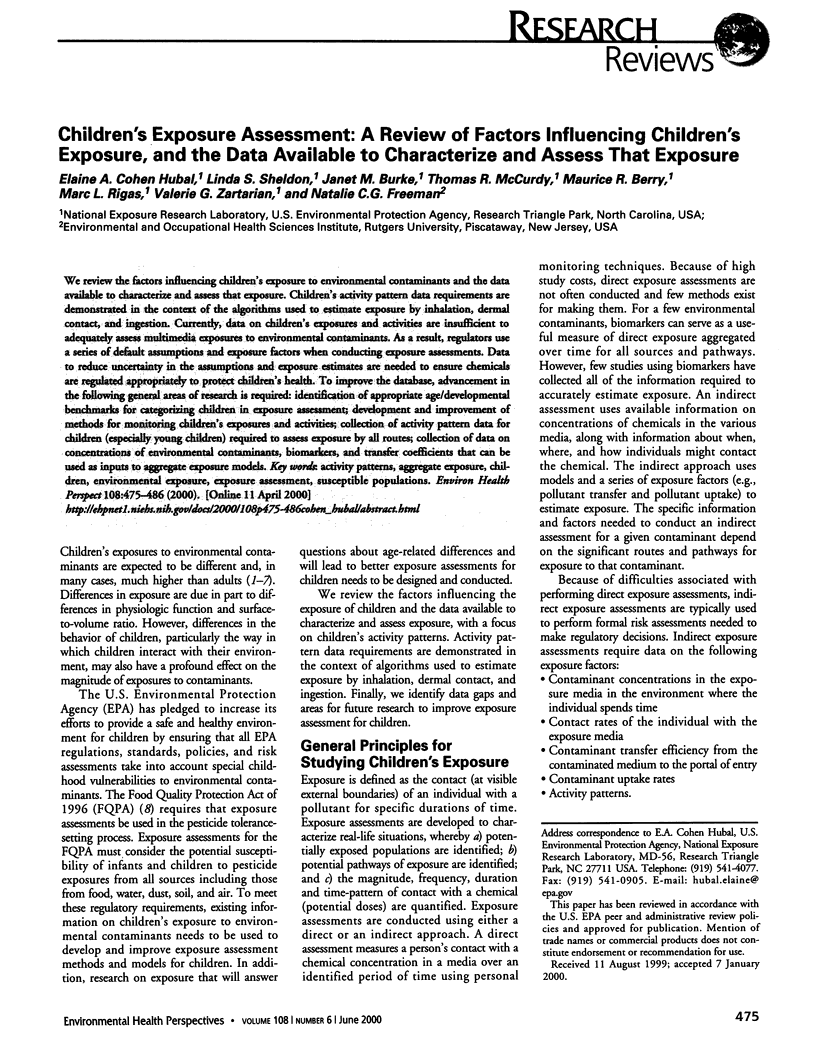
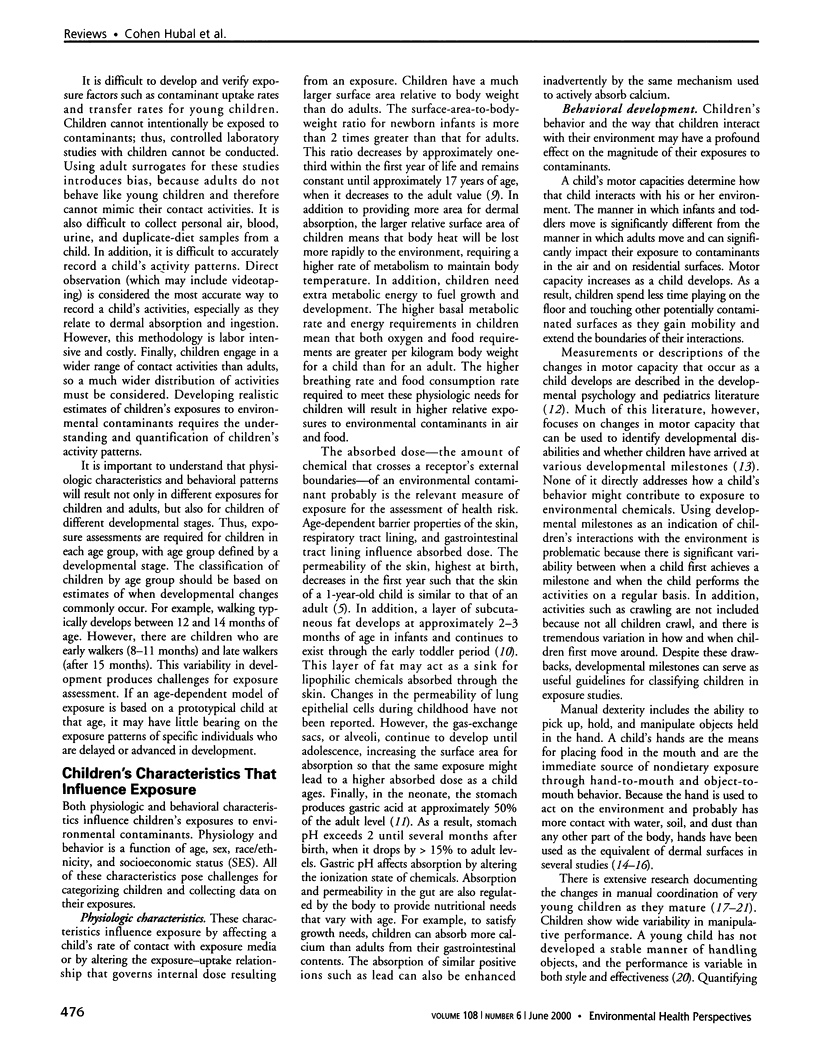
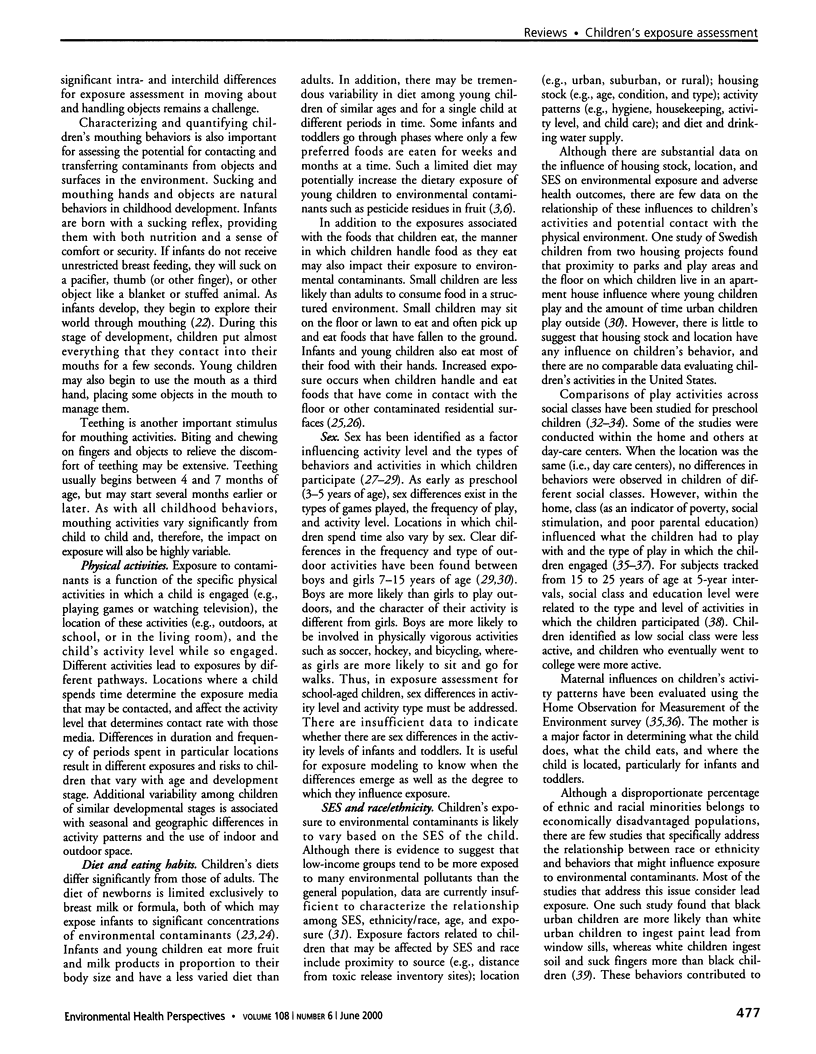
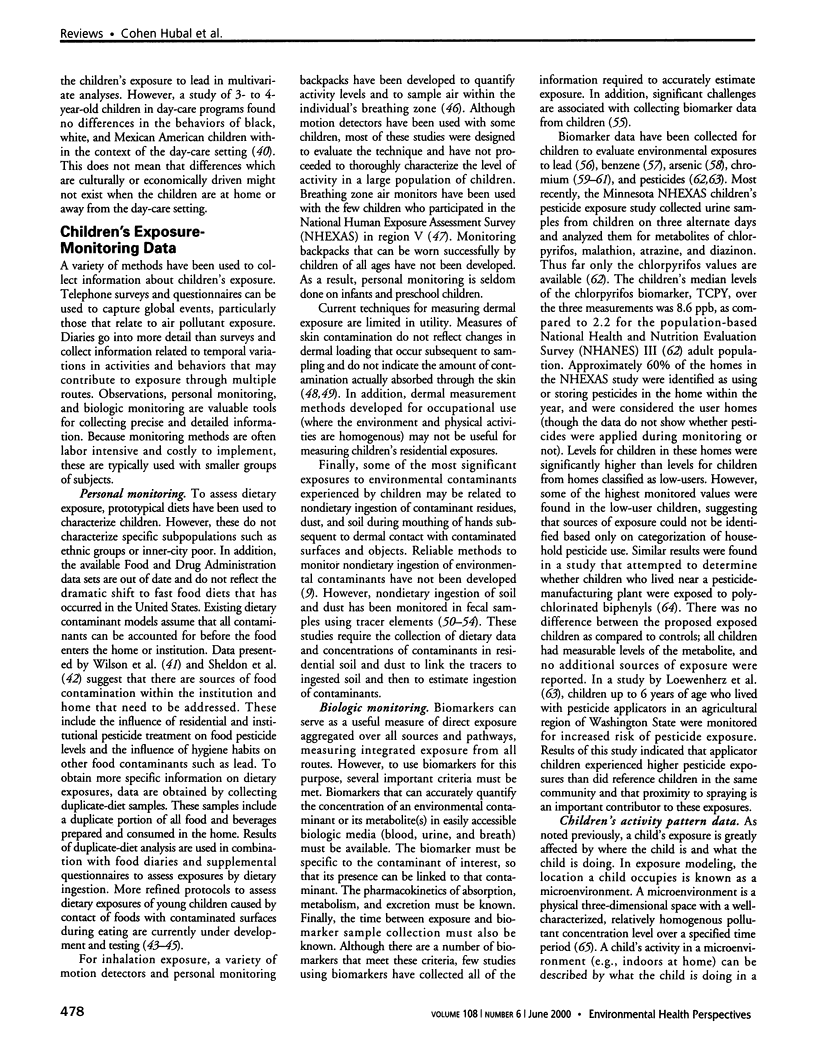
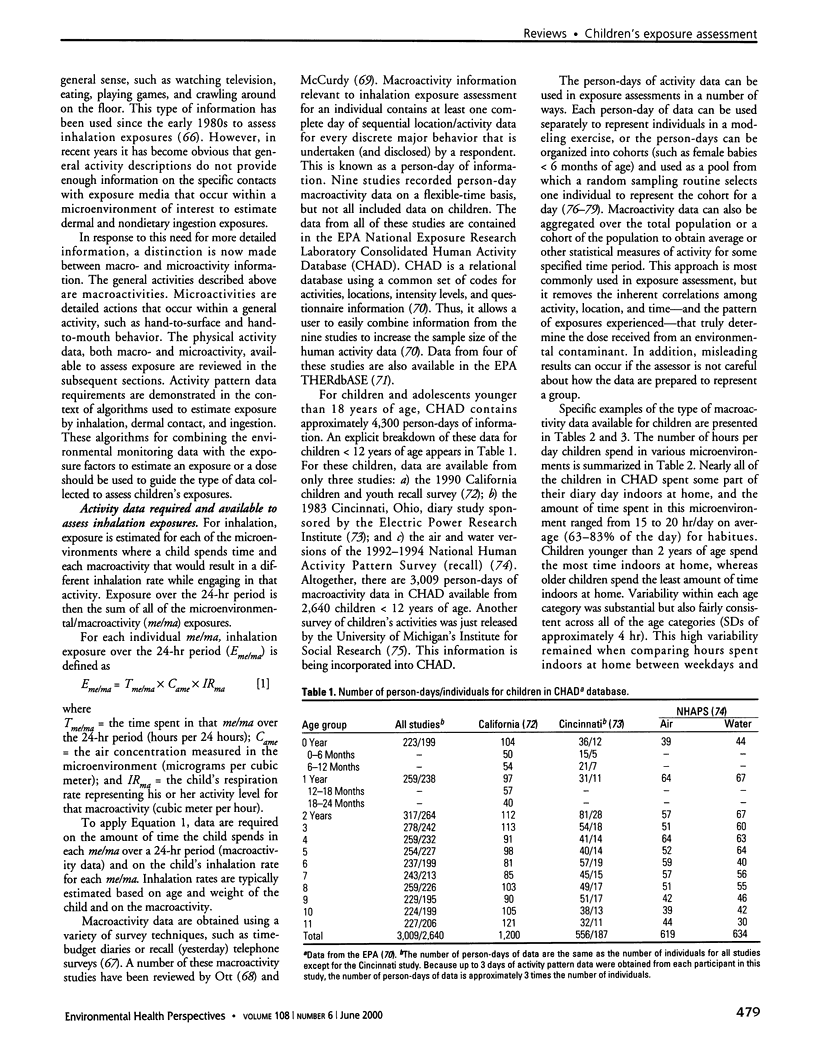
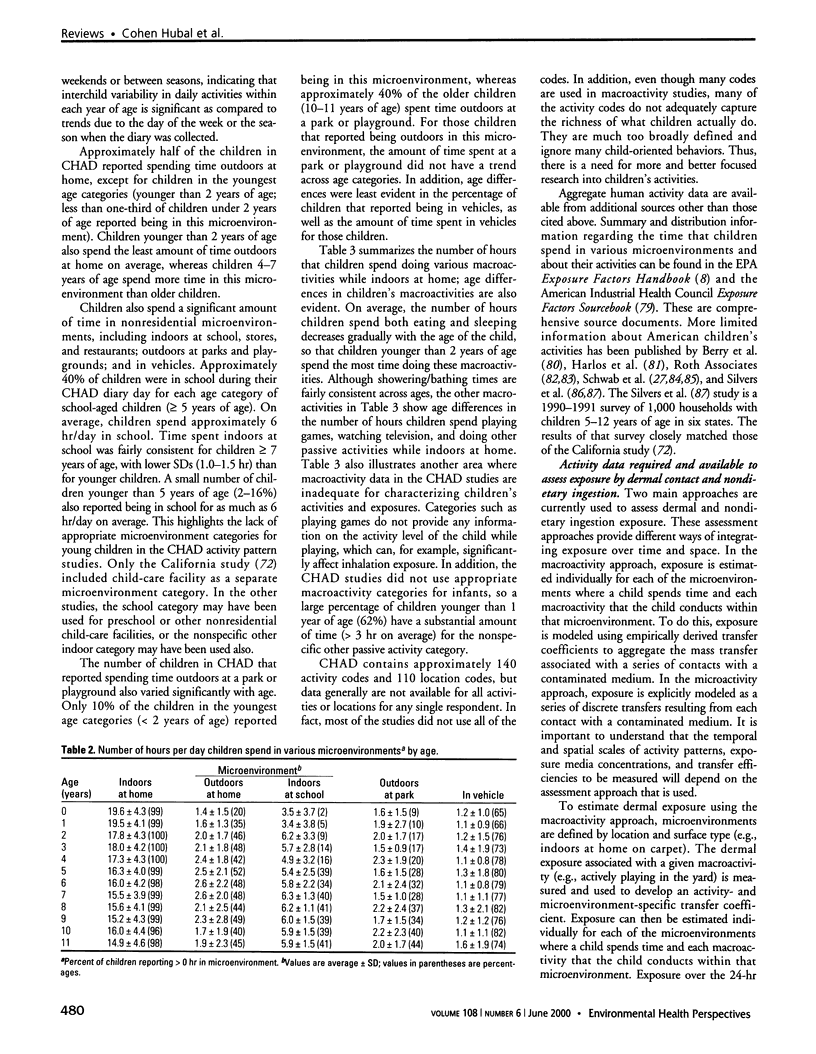
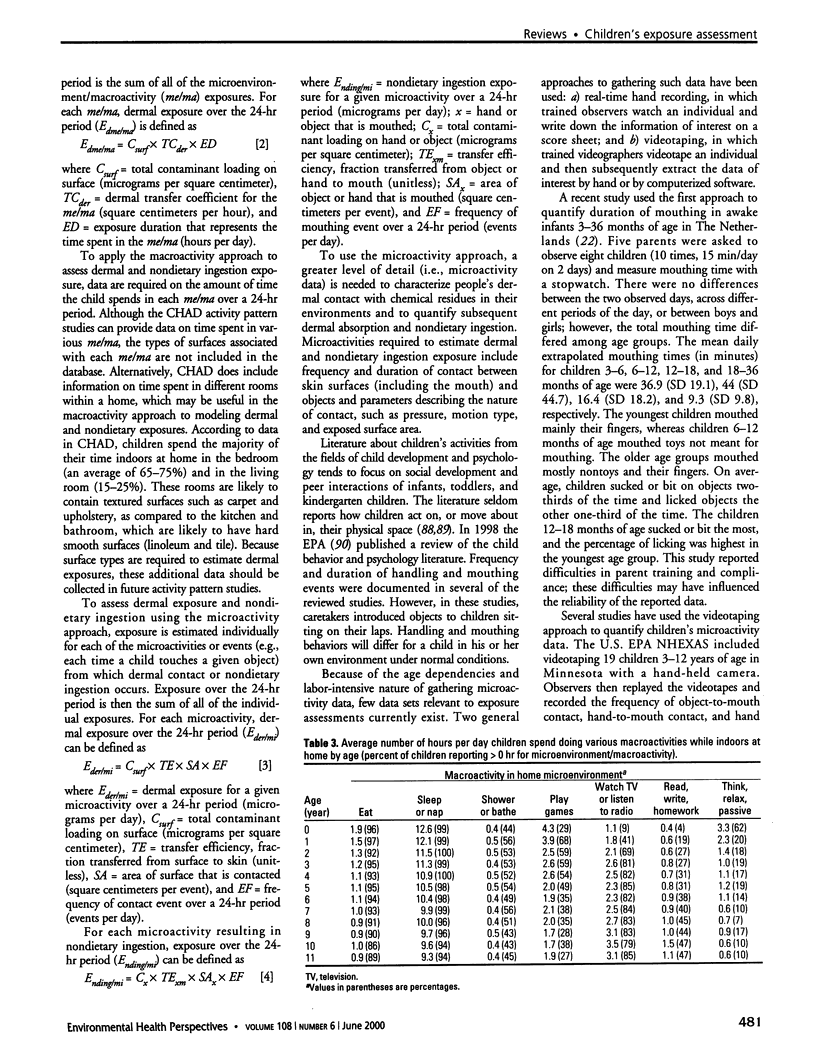
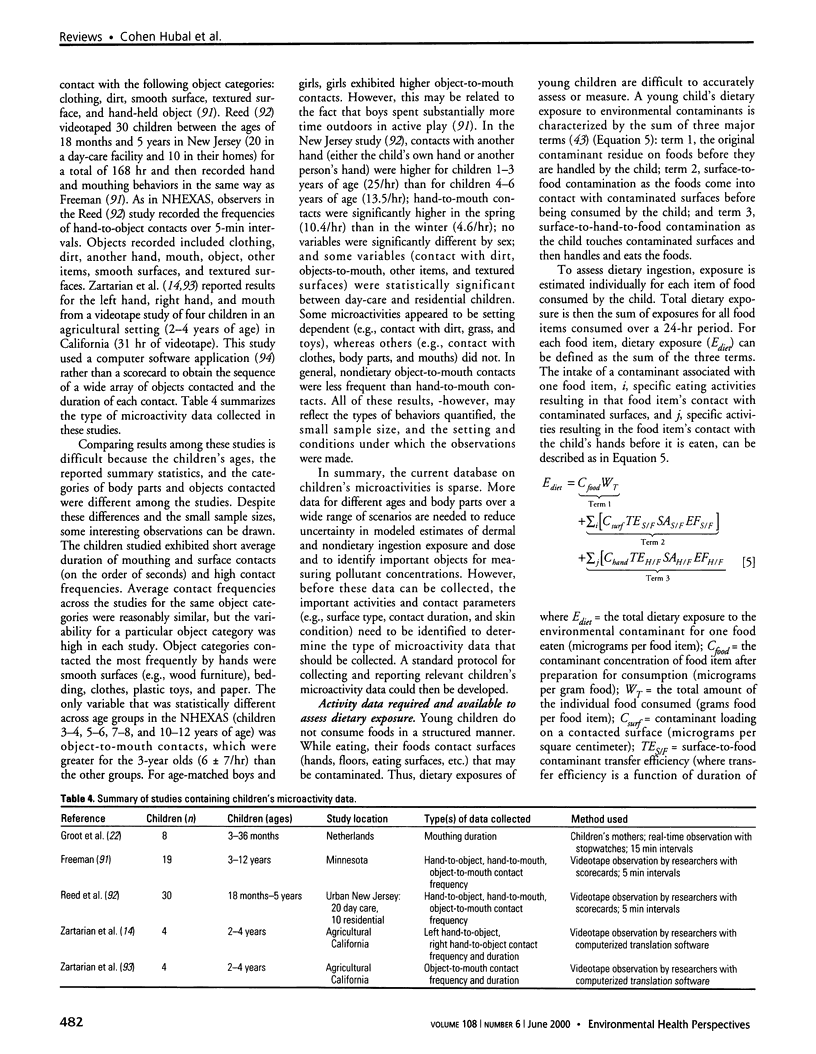
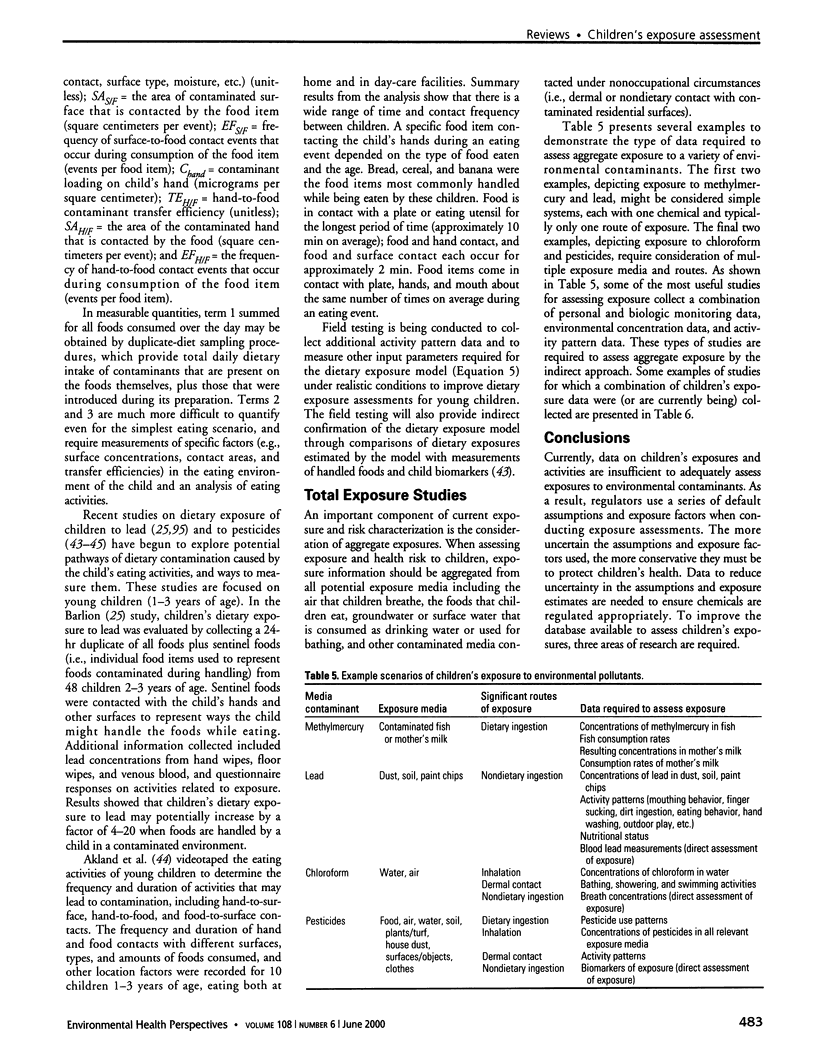
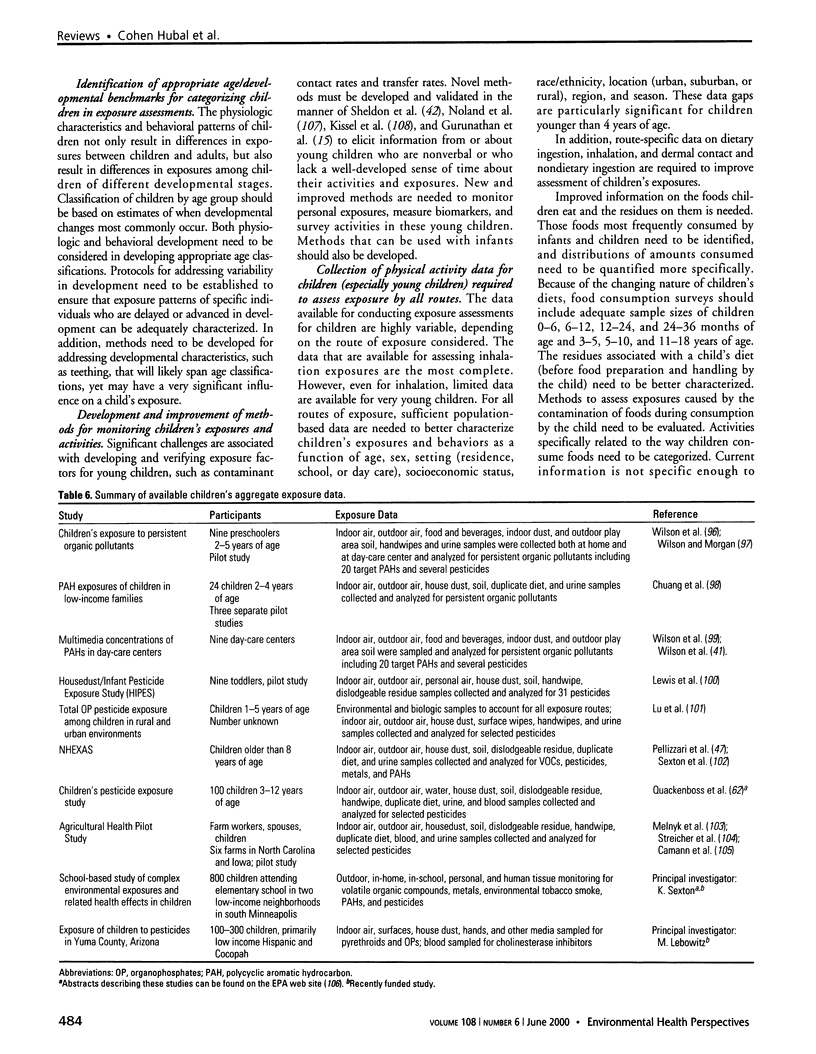
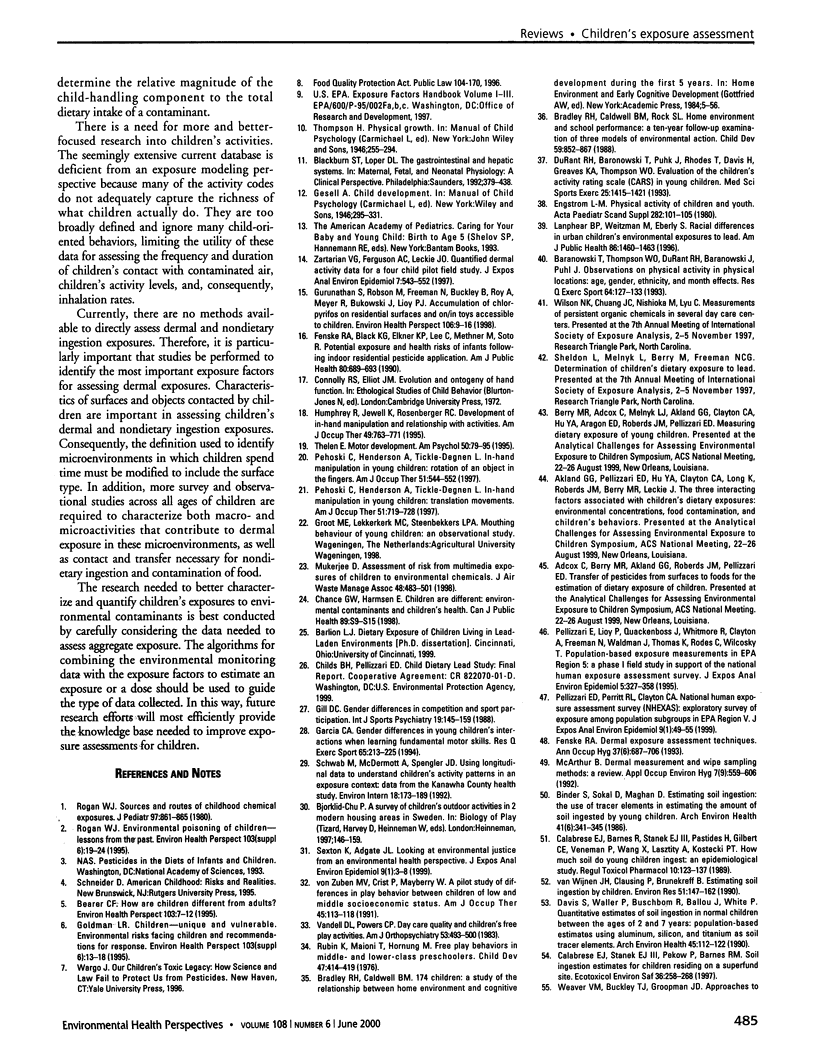
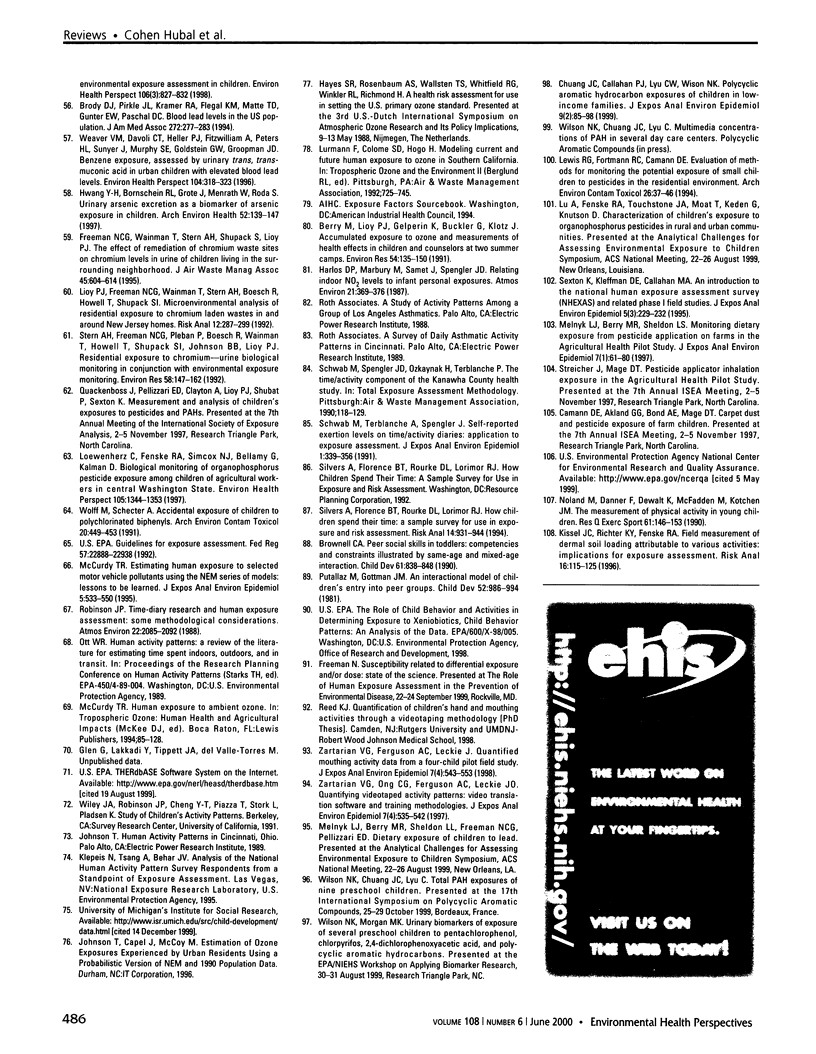
Selected References
These references are in PubMed. This may not be the complete list of references from this article.
- Baranowski T., Thompson W. O., DuRant R. H., Baranowski J., Puhl J. Observations on physical activity in physical locations: age, gender, ethnicity, and month effects. Res Q Exerc Sport. 1993 Jun;64(2):127–133. doi: 10.1080/02701367.1993.10608789. [DOI] [PubMed] [Google Scholar]
- Bearer C. F. How are children different from adults? Environ Health Perspect. 1995 Sep;103 (Suppl 6):7–12. doi: 10.1289/ehp.95103s67. [DOI] [PMC free article] [PubMed] [Google Scholar]
- Berry M., Lioy P. J., Gelperin K., Buckler G., Klotz J. Accumulated exposure to ozone and measurement of health effects in children and counselors at two summer camps. Environ Res. 1991 Apr;54(2):135–150. doi: 10.1016/s0013-9351(05)80096-9. [DOI] [PubMed] [Google Scholar]
- Binder S., Sokal D., Maughan D. Estimating soil ingestion: the use of tracer elements in estimating the amount of soil ingested by young children. Arch Environ Health. 1986 Nov-Dec;41(6):341–345. doi: 10.1080/00039896.1986.9935776. [DOI] [PubMed] [Google Scholar]
- Bradley R. H., Caldwell B. M., Rock S. L. Home environment and school performance: a ten-year follow-up and examination of three models of environmental action. Child Dev. 1988 Aug;59(4):852–867. doi: 10.1111/j.1467-8624.1988.tb03239.x. [DOI] [PubMed] [Google Scholar]
- Brody D. J., Pirkle J. L., Kramer R. A., Flegal K. M., Matte T. D., Gunter E. W., Paschal D. C. Blood lead levels in the US population. Phase 1 of the Third National Health and Nutrition Examination Survey (NHANES III, 1988 to 1991) JAMA. 1994 Jul 27;272(4):277–283. doi: 10.1001/jama.272.4.277. [DOI] [PubMed] [Google Scholar]
- Brownell C. A. Peer social skills in toddlers: competencies and constraints illustrated by same-age and mixed-age interaction. Child Dev. 1990 Jun;61(3):838–848. [PubMed] [Google Scholar]
- Calabrese E. J., Barnes R., Stanek E. J., 3rd, Pastides H., Gilbert C. E., Veneman P., Wang X. R., Lasztity A., Kostecki P. T. How much soil do young children ingest: an epidemiologic study. Regul Toxicol Pharmacol. 1989 Oct;10(2):123–137. doi: 10.1016/0273-2300(89)90019-6. [DOI] [PubMed] [Google Scholar]
- Calabrese E. J., Stanek E. J., 3rd, Pekow P., Barnes R. M. Soil ingestion estimates for children residing on a superfund site. Ecotoxicol Environ Saf. 1997 Apr;36(3):258–268. doi: 10.1006/eesa.1996.1511. [DOI] [PubMed] [Google Scholar]
- Chance G. W., Harmsen E. Children are different: environmental contaminants and children's health. Can J Public Health. 1998 May-Jun;89 (Suppl 1):S9-13, S10-5. [PubMed] [Google Scholar]
- Chuang J. C., Callahan P. J., Lyu C. W., Wilson N. K. Polycyclic aromatic hydrocarbon exposures of children in low-income families. J Expo Anal Environ Epidemiol. 1999 Mar-Apr;9(2):85–98. doi: 10.1038/sj.jea.7500003. [DOI] [PubMed] [Google Scholar]
- Davis S., Waller P., Buschbom R., Ballou J., White P. Quantitative estimates of soil ingestion in normal children between the ages of 2 and 7 years: population-based estimates using aluminum, silicon, and titanium as soil tracer elements. Arch Environ Health. 1990 Mar-Apr;45(2):112–122. doi: 10.1080/00039896.1990.9935935. [DOI] [PubMed] [Google Scholar]
- DuRant R. H., Baranowski T., Puhl J., Rhodes T., Davis H., Greaves K. A., Thompson W. O. Evaluation of the Children's Activity Rating Scale (CARS) in young children. Med Sci Sports Exerc. 1993 Dec;25(12):1415–1421. [PubMed] [Google Scholar]
- Engström L. M. Physical activity of children and youth. Acta Paediatr Scand Suppl. 1980;283:101–105. doi: 10.1111/j.1651-2227.1980.tb15329.x. [DOI] [PubMed] [Google Scholar]
- Fenske R. A., Black K. G., Elkner K. P., Lee C. L., Methner M. M., Soto R. Potential exposure and health risks of infants following indoor residential pesticide applications. Am J Public Health. 1990 Jun;80(6):689–693. doi: 10.2105/ajph.80.6.689. [DOI] [PMC free article] [PubMed] [Google Scholar]
- Freeman N. C., Wainman T., Lioy P. J., Stern A. H., Shupack S. I. The effect of remediation of chromium waste sites on chromium levels in urine of children living in the surrounding neighborhood. J Air Waste Manag Assoc. 1995 Aug;45(8):604–614. doi: 10.1080/10473289.1995.10467390. [DOI] [PubMed] [Google Scholar]
- Garcia C. Gender differences in young children's interactions when learning fundamental motor skills. Res Q Exerc Sport. 1994 Sep;65(3):213–225. doi: 10.1080/02701367.1994.10607622. [DOI] [PubMed] [Google Scholar]
- Goldman L. R. Children--unique and vulnerable. Environmental risks facing children and recommendations for response. Environ Health Perspect. 1995 Sep;103 (Suppl 6):13–18. doi: 10.1289/ehp.95103s613. [DOI] [PMC free article] [PubMed] [Google Scholar]
- Gurunathan S., Robson M., Freeman N., Buckley B., Roy A., Meyer R., Bukowski J., Lioy P. J. Accumulation of chlorpyrifos on residential surfaces and toys accessible to children. Environ Health Perspect. 1998 Jan;106(1):9–16. doi: 10.1289/ehp.981069. [DOI] [PMC free article] [PubMed] [Google Scholar]
- Humphry R., Jewell K., Rosenberger R. C. Development of in-hand manipulation and relationship with activities. Am J Occup Ther. 1995 Sep;49(8):763–771. doi: 10.5014/ajot.49.8.763. [DOI] [PubMed] [Google Scholar]
- Hwang Y. H., Bornschein R. L., Grote J., Menrath W., Roda S. Urinary arsenic excretion as a biomarker of arsenic exposure in children. Arch Environ Health. 1997 Mar-Apr;52(2):139–147. doi: 10.1080/00039899709602878. [DOI] [PubMed] [Google Scholar]
- Kissel J. C., Richter K. Y., Fenske R. A. Field measurement of dermal soil loading attributable to various activities: implications for exposure assessment. Risk Anal. 1996 Feb;16(1):115–125. doi: 10.1111/j.1539-6924.1996.tb01441.x. [DOI] [PubMed] [Google Scholar]
- Lanphear B. P., Weitzman M., Eberly S. Racial differences in Urban children's environmental exposures to lead. Am J Public Health. 1996 Oct;86(10):1460–1463. doi: 10.2105/ajph.86.10.1460. [DOI] [PMC free article] [PubMed] [Google Scholar]
- Lewis R. G., Fortmann R. C., Camann D. E. Evaluation of methods for monitoring the potential exposure of small children to pesticides in the residential environment. Arch Environ Contam Toxicol. 1994 Jan;26(1):37–46. doi: 10.1007/BF00212792. [DOI] [PubMed] [Google Scholar]
- Lioy P. J., Freeman N. C., Wainman T., Stern A. H., Boesch R., Howell T., Shupack S. I. Microenvironmental analysis of residential exposure to chromium-laden wastes in and around New Jersey homes. Risk Anal. 1992 Jun;12(2):287–299. doi: 10.1111/j.1539-6924.1992.tb00676.x. [DOI] [PubMed] [Google Scholar]
- Loewenherz C., Fenske R. A., Simcox N. J., Bellamy G., Kalman D. Biological monitoring of organophosphorus pesticide exposure among children of agricultural workers in central Washington State. Environ Health Perspect. 1997 Dec;105(12):1344–1353. doi: 10.1289/ehp.971051344. [DOI] [PMC free article] [PubMed] [Google Scholar]
- McCurdy T. Estimating human exposure to selected motor vehicle pollutants using the NEM series of models: lessons to be learned. J Expo Anal Environ Epidemiol. 1995 Oct-Dec;5(4):533–550. [PubMed] [Google Scholar]
- Melnyk L. J., Berry M. R., Sheldon L. S. Dietary exposure from pesticide application on farms in the Agricultural Health Pilot Study. J Expo Anal Environ Epidemiol. 1997 Jan-Mar;7(1):61–80. [PubMed] [Google Scholar]
- Mukerjee D. Assessment of risk from multimedia exposures of children to environmental chemicals. J Air Waste Manag Assoc. 1998 Jun;48(6):483–501. doi: 10.1080/10473289.1998.10463703. [DOI] [PubMed] [Google Scholar]
- Noland M., Danner F., DeWalt K., McFadden M., Kotchen J. M. The measurement of physical activity in young children. Res Q Exerc Sport. 1990 Jun;61(2):146–153. doi: 10.1080/02701367.1990.10608668. [DOI] [PubMed] [Google Scholar]
- Pehoski C., Henderson A., Tickle-Degnen L. In-hand manipulation in young children: rotation of an object in the fingers. Am J Occup Ther. 1997 Jul-Aug;51(7):544–552. doi: 10.5014/ajot.51.7.544. [DOI] [PubMed] [Google Scholar]
- Pehoski C., Henderson A., Tickle-Degnen L. In-hand manipulation in young children: translation movements. Am J Occup Ther. 1997 Oct;51(9):719–728. doi: 10.5014/ajot.51.9.719. [DOI] [PubMed] [Google Scholar]
- Rogan W. J. Environmental poisoning of children--lessons from the past. Environ Health Perspect. 1995 Sep;103 (Suppl 6):19–23. doi: 10.1289/ehp.95103s619. [DOI] [PMC free article] [PubMed] [Google Scholar]
- Rogan W. J. The sources and routes of childhood chemical exposures. J Pediatr. 1980 Nov;97(5):861–865. doi: 10.1016/s0022-3476(80)80289-7. [DOI] [PubMed] [Google Scholar]
- Schwab M., Terblanche A. P., Spengler J. D. Self-reported exertion levels on time/activity diaries: application to exposure assessment. J Expo Anal Environ Epidemiol. 1991 Jul;1(3):339–356. [PubMed] [Google Scholar]
- Sexton K., Adgate J. L. Looking at environmental justice from an environmental health perspective. J Expo Anal Environ Epidemiol. 1999 Jan-Feb;9(1):3–8. doi: 10.1038/sj.jea.7500021. [DOI] [PubMed] [Google Scholar]
- Sexton K., Kleffman D. E., Callahan M. A. An introduction to the National Human Exposure Assessment Survey (NHEXAS) and related phase I field studies. J Expo Anal Environ Epidemiol. 1995 Jul-Sep;5(3):229–232. [PubMed] [Google Scholar]
- Silvers A., Florence B. T., Rourke D. L., Lorimor R. J. How children spend their time: a sample survey for use in exposure and risk assessments. Risk Anal. 1994 Dec;14(6):931–944. doi: 10.1111/j.1539-6924.1994.tb00062.x. [DOI] [PubMed] [Google Scholar]
- Stern A. H., Freeman N. C., Pleban P., Boesch R. R., Wainman T., Howell T., Shupack S. I., Johnson B. B., Lioy P. J. Residential exposure to chromium waste--urine biological monitoring in conjunction with environmental exposure monitoring. Environ Res. 1992 Aug;58(2):147–162. doi: 10.1016/s0013-9351(05)80211-7. [DOI] [PubMed] [Google Scholar]
- Thelen E. Motor development. A new synthesis. Am Psychol. 1995 Feb;50(2):79–95. doi: 10.1037//0003-066x.50.2.79. [DOI] [PubMed] [Google Scholar]
- Vandell D. L., Powers C. P. Day care quality and children's free play activities. Am J Orthopsychiatry. 1983 Jul;53(3):493–500. doi: 10.1111/j.1939-0025.1983.tb03393.x. [DOI] [PubMed] [Google Scholar]
- Weaver V. M., Buckley T. J., Groopman J. D. Approaches to environmental exposure assessment in children. Environ Health Perspect. 1998 Jun;106 (Suppl 3):827–832. doi: 10.1289/ehp.98106827. [DOI] [PMC free article] [PubMed] [Google Scholar]
- Weaver V. M., Davoli C. T., Heller P. J., Fitzwilliam A., Peters H. L., Sunyer J., Murphy S. E., Goldstein G. W., Groopman J. D. Benzene exposure, assessed by urinary trans,trans-muconic acid, in urban children with elevated blood lead levels. Environ Health Perspect. 1996 Mar;104(3):318–323. doi: 10.1289/ehp.96104318. [DOI] [PMC free article] [PubMed] [Google Scholar]
- Wolff M. S., Schecter A. Accidental exposure of children to polychlorinated biphenyls. Arch Environ Contam Toxicol. 1991 May;20(4):449–453. doi: 10.1007/BF01065832. [DOI] [PubMed] [Google Scholar]
- Zartarian V. G., Ferguson A. C., Leckie J. O. Quantified dermal activity data from a four-child pilot field study. J Expo Anal Environ Epidemiol. 1997 Oct-Dec;7(4):543–552. [PubMed] [Google Scholar]
- Zartarian V. G., Ferguson A. C., Ong C. G., Leckie J. O. Quantifying videotaped activity patterns: video translation software and training methodologies. J Expo Anal Environ Epidemiol. 1997 Oct-Dec;7(4):535–542. [PubMed] [Google Scholar]
- van Wijnen J. H., Clausing P., Brunekreef B. Estimated soil ingestion by children. Environ Res. 1990 Apr;51(2):147–162. doi: 10.1016/s0013-9351(05)80085-4. [DOI] [PubMed] [Google Scholar]


